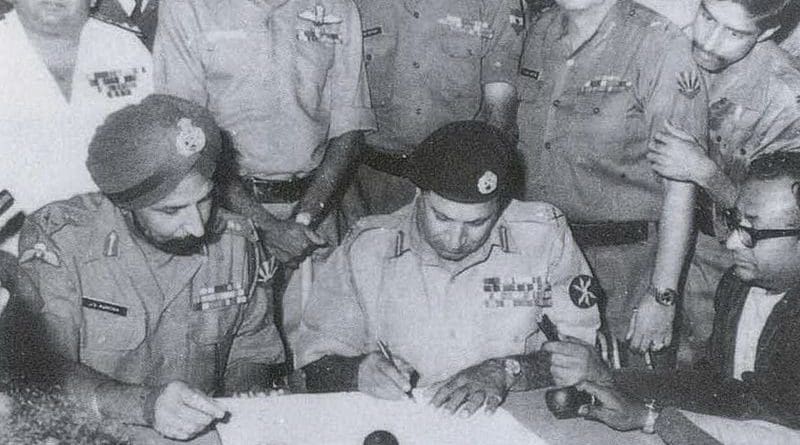Tormented Truth About 1971 Indo-Pakistani War – OpEd
The 1971 war is one of the most misreported and misunderstood conflicts in history. It is imperative to get rid of the myth of genocide of three million Bengalis in 1971, as the old wounds are opened every year for petty gains by neighboring India. Pakistan has never been interested in “reclaiming” East Pakistan, but the truth of 1971 must be told. Through a systematic malicious campaign, Pakistanis in particular, and the world in general, have been led to believe a version of history that holds Pakistan responsible for everything that happened in East Pakistan.
However, actual evidence and sequence of events tell us quite a different story, one which morally bankrupt pseudo- historians, would rather ignore. The fact is that non-Bengali minorities were brutally murdered by “Bengali fascists”. What exactly was the intention of targeting them was not clear, but one can reasonably argue that the resulting
chaos facilitated disintegration of Pakistan.
To start with, one of the most bogus allegations regarding genocide of three million in 1971 crisis is a fabricated and planned narrative against Pakistan. This controversy which is still alive, was first tossed by Sheikh Mujibur Rahman, where he misquoted 3 lakh as 3 million in an interview with a BBC journalist Sir David Frost on 8 January 1972. It is evident from the fact that Serajur Rahman, the Deputy Head of BBC Bengali Service expressed his surprise at Mujib’s figures of 3 million Bangladeshi deaths in the war. In a letter to The Guardian on 24 May 2011, he stated that he mentioned to Mujib, on 8 January 1972, the figure of three lakh as their estimate of death toll in 1971 war, but Mujib in an interview with David Frost, mentioned the figure to be 3 million, which may be a mistranslation or a confusion. This illogical and unabashed absurdity of the 3 million was later used by Indians without any empirical data to prove it.
Similarly, author Sarmila Bose in her book, “Dead Reckoning – a long-overdue dispassionate study of 1971 war,” after carrying out case-by-case arithmetic – concludes that between 50,000 and 100,000 people died in 1971 – vastly away from the figure of 3 million that is sacrosanct in Bangladesh.
The narrative like “ethnic cleansing and genocide by the Pakistan Army” was coined and amplified by the Indian side. During 1971, even before the direct military intervention, Mukti Bahini was being provided military, logistic, and economic support by India. Indian Air Force organised four “Hunter Squadrons, one Sukhoi Squadron, three Gnat Squadrons and three MiG-21 Squadrons”. Major General Oban of the Indian army who was an expert in guerrilla warfare, hired the best fighters of Bahini group named as Mujib Bahini. General Oban provided them political and military training. Mukti Bahini Sector Commander, Lt. Col. Kazi Nuruzzaman, who was the principal commander of Mukti Bahini stated: “Having received the training, political commandos found it embarrassing to identify themselves as products of the Indian authorities. So, they gave
themselves the name of Bangladesh Liberation Force.”
Another source quoted that “Mukti Bahini killed around 100,000 Biharis (according to the ‘Chronology for Biharis in Bangladesh’) to 150,000 Biharis (according to the ‘Encyclopedia of Violence, Peace and Conflict; page 64). Qutubuddin Aziz, in ‘Blood and Tears’, has documented 170 eye-witness accounts of the ‘atrocities committed on Biharis and other non-Bengalis’ across 55 towns, covering ‘110 places where the slaughter of the innocents took place.”
All this validates that it wasn’t a real uprising in East Pakistan but an Indian-induced insurgency, which was aimed at breaking up of Pakistan on the basis of ethnicity. India crafted the whole plan and executed it with the support of its military and intelligence agencies. Archer Blood, an American career diplomat – who served as the last U.S. Consul General to Dhaka stated:
“Indian soil was made available for training camps, hospitals and supply depots for the Mukti Bahini” and these guerrilla fighters had a “safe haven to which it could retire for rest, food, medical supplies and weapons.”
According to Lawrence Lifschultz, South Asia correspondent for Far Eastern Economic Review, Mukti Bahini leader, Abdul Kader Siddiqui, “personally bayoneted” non-Bengalis to death and the entire incident was filmed by foreign film crews whom Siddiqui had invited to witness the spectacle.
As per professor of history Yasmin Saikia’s “Women, War and the Making of Bangladesh”, Bihari women were assaulted and arduously tortured by Bahini’s guerrilla fighters. She added, thousands of Bihari women were raped and tortured by Mukti Bahini. More than 20,000 Biharis were massacred by Bengalis in Khulna jute mills – including men, women, and children. Some were burnt alive; others were guillotined.
The involvement of Indian government in East Pakistan debacle started much earlier than 1971. Ashok Raina, author, and writer of “Inside RAW: The story of India’s secret service” believed that the debacle of East Pakistan schemes started much earlier around 1962-63. The debacle of 1971 started with planned cold-blooded homicides, rape, and tortures with the help of RAW.
Unfortunately, it was the Awami League that kept the facts hidden and not allowed them to be included in the history of Bangladesh. For its part, Pakistan’s government has so far remained reticent. It is high time that the issue is raised at both national and international fora for an open inquiry into those killings. Pakistan owes it to those who gave their lives in 1947 for the creation of the motherland – Pakistan and, then for its unity in 1971.


Hi, Dear expert:
Why cry about it, now? You know Pakistan was/still is not at peace with itself or with its neighbors (Afghan or India)–Bangladesh is making progress being friendly with India.
Can you see Merit in that?